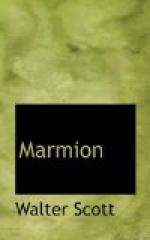Stanza xxvi. lines 535-538. The proper names in these lines are Hebrides; East Lothian; Redswire, part of Carter Fell near Jedburgh; and co. of Ross.
Stanza xxvii. line 557. ’Seven culverins so called, cast by one Borthwick.’—Scott.
Stanza xxviii. line 566. ’Each ensign intimated a different rank.’— Scott.
line 567. As illustrating an early mode of English encampment, Scott quotes from Patten’s description of what he saw after Pinkie, 1547:- -
’As they had no pavilions, or round houses, of any commendable compass, so wear there few other tentes with posts, as the used manner of making is; and of these few also, none of above twenty foot length, but most far under; for the most part all very sumptuously beset, (after their fashion,) for the love of France, with fleur-de-lys, some of blue buckeram, some of black, and some of some other colours. These white ridges, as I call them, that, as we stood on Fauxsyde Bray, did make so great muster toward us, which I did take then to be a number of tentes, when we came, we found it a linen drapery, of the coarser cambryk in dede, for it was all of canvas sheets, and wear the tenticles, or rather cabyns and couches of their soldiers; the which (much after the common building of their country beside) had they framed of four sticks, about an ell long a piece, whereof two fastened together at one end aloft, and the two endes beneath stuck in the ground, an ell asunder, standing in fashion like the bowes of a sowes yoke; over two such bowes (one, as it were, at their head, the other at their feet), they stretched a sheet down on both sides, whereby their cabin became roofed like a ridge, but skant shut at both ends, and not very close beneath on the sides, unless their sticks were the shorter, or their wives the more liberal to lend them larger napery; howbeit, when they had lined them, and stuff’d them so thick with straw, with the weather as it was not very cold, when they wear ones couched, they were as warm as they had been wrapt in horses dung.’—Patten’s Account of Somerset’s Expedition.
line 578. ’The well-known arms of Scotland. If you will believe Boethius and Buchanan, the double tressure round the shield (mentioned above, vii. 141), counter fleur-de-lysed, or lingued and armed azure, was first assumed by Achaias, King of Scotland, contemporary of Charlemagne, and founder of the celebrated League with France but later antiquaries make poor Eochy, or Achy, little better than a sort of King of Brentford, whom old Grig (who has also swelled into Gregorius Magnus) associated with himself in the important duty of governing some part of the north-eastern coast of Scotland.’—Scott.




